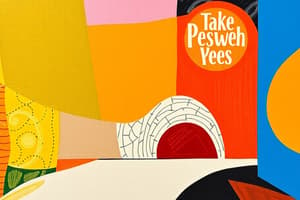Podcast
Questions and Answers
Approximately what percentage of additional costs are associated with incorporating universal design features?
Approximately what percentage of additional costs are associated with incorporating universal design features?
- 20-25%
- 1-2% (correct)
- 5-10%
- 10-15%
Harry Sprintz has been making universal design a core feature of his designs for approximately 20 years.
Harry Sprintz has been making universal design a core feature of his designs for approximately 20 years.
False (B)
Name the Australian act that designers should be familiar with in relation to accessibility.
Name the Australian act that designers should be familiar with in relation to accessibility.
Disability Discrimination Act 1992 (DDA)
Brian Kidd is involved in a project translating research into practice for _______ environments.
Brian Kidd is involved in a project translating research into practice for _______ environments.
Match the following individuals with their area of expertise.
Match the following individuals with their area of expertise.
What is a common misconception about people with disabilities?
What is a common misconception about people with disabilities?
The author suggests that human ability can be clearly divided into 'abled' and 'disabled' categories.
The author suggests that human ability can be clearly divided into 'abled' and 'disabled' categories.
What does the author consider the ideal solution for designing buildings for mobility issues?
What does the author consider the ideal solution for designing buildings for mobility issues?
Designing in accordance with ___________ principles can help achieve invisible accessibility.
Designing in accordance with ___________ principles can help achieve invisible accessibility.
Match the following concepts with their descriptions:
Match the following concepts with their descriptions:
What does the article suggest about defining 'disability'?
What does the article suggest about defining 'disability'?
The article implies that people with disabilities all have identical needs.
The article implies that people with disabilities all have identical needs.
According to the author, what is the main goal of 'good' universal design?
According to the author, what is the main goal of 'good' universal design?
What was the main goal of the McIntyre Social Housing project design?
What was the main goal of the McIntyre Social Housing project design?
The McIntyre Drive Social Housing project used expensive materials to achieve sustainability.
The McIntyre Drive Social Housing project used expensive materials to achieve sustainability.
Who is credited with pioneering the concept of universal design?
Who is credited with pioneering the concept of universal design?
What type of heating system was used in the McIntyre Drive Social Housing project?
What type of heating system was used in the McIntyre Drive Social Housing project?
Good universal design is often considered ______ within an overall design concept.
Good universal design is often considered ______ within an overall design concept.
Universal design aims to create products and environments that are usable by all people to the greatest extent possible.
Universal design aims to create products and environments that are usable by all people to the greatest extent possible.
Match the following architects/consultants with their area of expertise based on the text:
Match the following architects/consultants with their area of expertise based on the text:
What is one benefit of universal design besides accessibility?
What is one benefit of universal design besides accessibility?
What construction method aided in reducing tenant utility costs for the McIntyre Social Housing?
What construction method aided in reducing tenant utility costs for the McIntyre Social Housing?
The concept of ability should be viewed as a __________, which changes throughout our lives.
The concept of ability should be viewed as a __________, which changes throughout our lives.
Match each principle of universal design to a description:
Match each principle of universal design to a description:
The McIntyre Social Housing project was specifically designed for very wealthy people.
The McIntyre Social Housing project was specifically designed for very wealthy people.
Besides courtyards, balconies and terraces, what other private open space did the McIntyre Social Housing provide?
Besides courtyards, balconies and terraces, what other private open space did the McIntyre Social Housing provide?
What is a common misconception about the range of human ability?
What is a common misconception about the range of human ability?
Incorporating universal design principles will always compromise aesthetic design and increase costs.
Incorporating universal design principles will always compromise aesthetic design and increase costs.
What is one example of how people with typical abilities might be ‘disabled’ in some situations?
What is one example of how people with typical abilities might be ‘disabled’ in some situations?
Who received the United Nations Human Settlements Programme Habitat Scroll of Honour for his work?
Who received the United Nations Human Settlements Programme Habitat Scroll of Honour for his work?
There is significant regulatory control over the supply of accessible private dwellings.
There is significant regulatory control over the supply of accessible private dwellings.
What type of design should also be considered when applying universal design principles?
What type of design should also be considered when applying universal design principles?
Designers should be familiar with the goals of inclusive design, barrier-free design and _________ enabling environment design.
Designers should be familiar with the goals of inclusive design, barrier-free design and _________ enabling environment design.
Match the following design concepts with their description:
Match the following design concepts with their description:
What type of buildings are generally required to comply with certain obligations in respect to accessibility?
What type of buildings are generally required to comply with certain obligations in respect to accessibility?
Universalism, from which universal design is derived, is presented as a practical concept.
Universalism, from which universal design is derived, is presented as a practical concept.
What expertise should an access consultant ideally have, according to the text?
What expertise should an access consultant ideally have, according to the text?
Which of the following best describes the focus of the ACT's proposed amendments to the Building Code of Australia (BCA)?
Which of the following best describes the focus of the ACT's proposed amendments to the Building Code of Australia (BCA)?
Banyule City Council's accessibility requirements are based exclusively on the Australian Standards for accessible design.
Banyule City Council's accessibility requirements are based exclusively on the Australian Standards for accessible design.
What does VDD stand for, according to the provided text?
What does VDD stand for, according to the provided text?
The sensory room designed by Spacebar Studio utilizes natural materiality and ______ design considerations.
The sensory room designed by Spacebar Studio utilizes natural materiality and ______ design considerations.
What is the primary purpose of the sensory room designed for Inka Respite?
What is the primary purpose of the sensory room designed for Inka Respite?
Universal design can completely eliminate the need for assistive technology for all individuals.
Universal design can completely eliminate the need for assistive technology for all individuals.
Which Australian state is Inka Respite located in?
Which Australian state is Inka Respite located in?
Match the following organizations with their primary focus in the text:
Match the following organizations with their primary focus in the text:
Flashcards
Universal Design
Universal Design
A design approach that aims to create spaces and products usable by everyone, regardless of their abilities or disabilities. It prioritizes accessibility and inclusivity for all.
Fringe Group Misconception
Fringe Group Misconception
The misconception that people with disabilities are a separate, marginalized group, rather than individuals with diverse needs and preferences.
Accessibility
Accessibility
The ability to use a space or product without needing special adjustments or accommodations.
Disability as an Imposed Condition
Disability as an Imposed Condition
Signup and view all the flashcards
Invisible Accessibility Features
Invisible Accessibility Features
Signup and view all the flashcards
Invisible Accessibility
Invisible Accessibility
Signup and view all the flashcards
Universal Design Principles
Universal Design Principles
Signup and view all the flashcards
Universal Design's Wider Impact
Universal Design's Wider Impact
Signup and view all the flashcards
Ability Continuum
Ability Continuum
Signup and view all the flashcards
Access Consultant
Access Consultant
Signup and view all the flashcards
Regulatory Environment for Accessibility
Regulatory Environment for Accessibility
Signup and view all the flashcards
Principles of Universal Design
Principles of Universal Design
Signup and view all the flashcards
Equitable Use
Equitable Use
Signup and view all the flashcards
Dementia-enabling Environments
Dementia-enabling Environments
Signup and view all the flashcards
Wayfinding
Wayfinding
Signup and view all the flashcards
Flexibility in Use
Flexibility in Use
Signup and view all the flashcards
Simple and Intuitive
Simple and Intuitive
Signup and view all the flashcards
Perceptible Information
Perceptible Information
Signup and view all the flashcards
Tolerance for Error
Tolerance for Error
Signup and view all the flashcards
Accessible Design
Accessible Design
Signup and view all the flashcards
McIntyre Drive Social Housing
McIntyre Drive Social Housing
Signup and view all the flashcards
Reverse Masonry Construction
Reverse Masonry Construction
Signup and view all the flashcards
Hydronic Heating
Hydronic Heating
Signup and view all the flashcards
Stormwater Gardens
Stormwater Gardens
Signup and view all the flashcards
Australian Architects in Accessible Design
Australian Architects in Accessible Design
Signup and view all the flashcards
Invisible Universal Design
Invisible Universal Design
Signup and view all the flashcards
What are some key considerations for inclusive design?
What are some key considerations for inclusive design?
Signup and view all the flashcards
What is 'Equitable Use' in Universal Design?
What is 'Equitable Use' in Universal Design?
Signup and view all the flashcards
What is the aim of 'Universal Design'?
What is the aim of 'Universal Design'?
Signup and view all the flashcards
What is 'Wayfinding' in Universal Design?
What is 'Wayfinding' in Universal Design?
Signup and view all the flashcards
What is 'Flexibility in Use' for Universal Design?
What is 'Flexibility in Use' for Universal Design?
Signup and view all the flashcards
What are 'Dementia-enabling Environments'?
What are 'Dementia-enabling Environments'?
Signup and view all the flashcards
How does Universal Design impact a wider range of individuals?
How does Universal Design impact a wider range of individuals?
Signup and view all the flashcards
What is the 'Ability Continuum'?
What is the 'Ability Continuum'?
Signup and view all the flashcards
Sensory Room
Sensory Room
Signup and view all the flashcards
Biophilic Design
Biophilic Design
Signup and view all the flashcards
Sensory Design
Sensory Design
Signup and view all the flashcards
Study Notes
Universal Design - Assisting Accessibility
- Universal design aims for designs that are usable by all, to the greatest extent possible.
- It's about creating invisible accessibility features rather than obvious adaptations.
- Common misconception: disability is a fringe group, but preferences are diverse. Ability is a spectrum, and evolves.
- Universal design principles can achieve these outcomes: equitable use, flexibility in use, simple and intuitive, perceptible information, tolerance for error, low physical effort, and size and space for approach and use.
- Universal design was pioneered by Ron Mace.
- Dis/ability in a wider context: Some environments may create disability; universal design benefits people of all ages and circumstances.
- Significant consideration should be given to regulatory environments, like the Disability Discrimination Act 1992.
- Regulations relevant to accessibility exist but need improvement in regulations for private spaces.
- Accessible design is not inherently more expensive; often only 1-2% more costly to implement.
- Important to consider cognitive & sensory needs.
- Notable Australian experts in accessible design are mentioned, like Harry Sprintz, Brian Kidd, and Allen Kong.
Notable Australian Accessible Design Experts
- Harry Sprintz: Multi-award-winning architect and access consultant.
- Brian Kidd: Dementia specialist architect and access consultant.
- Allen Kong: Multi-award-winning architect and access consultant, known for aged care.
Studying That Suits You
Use AI to generate personalized quizzes and flashcards to suit your learning preferences.




